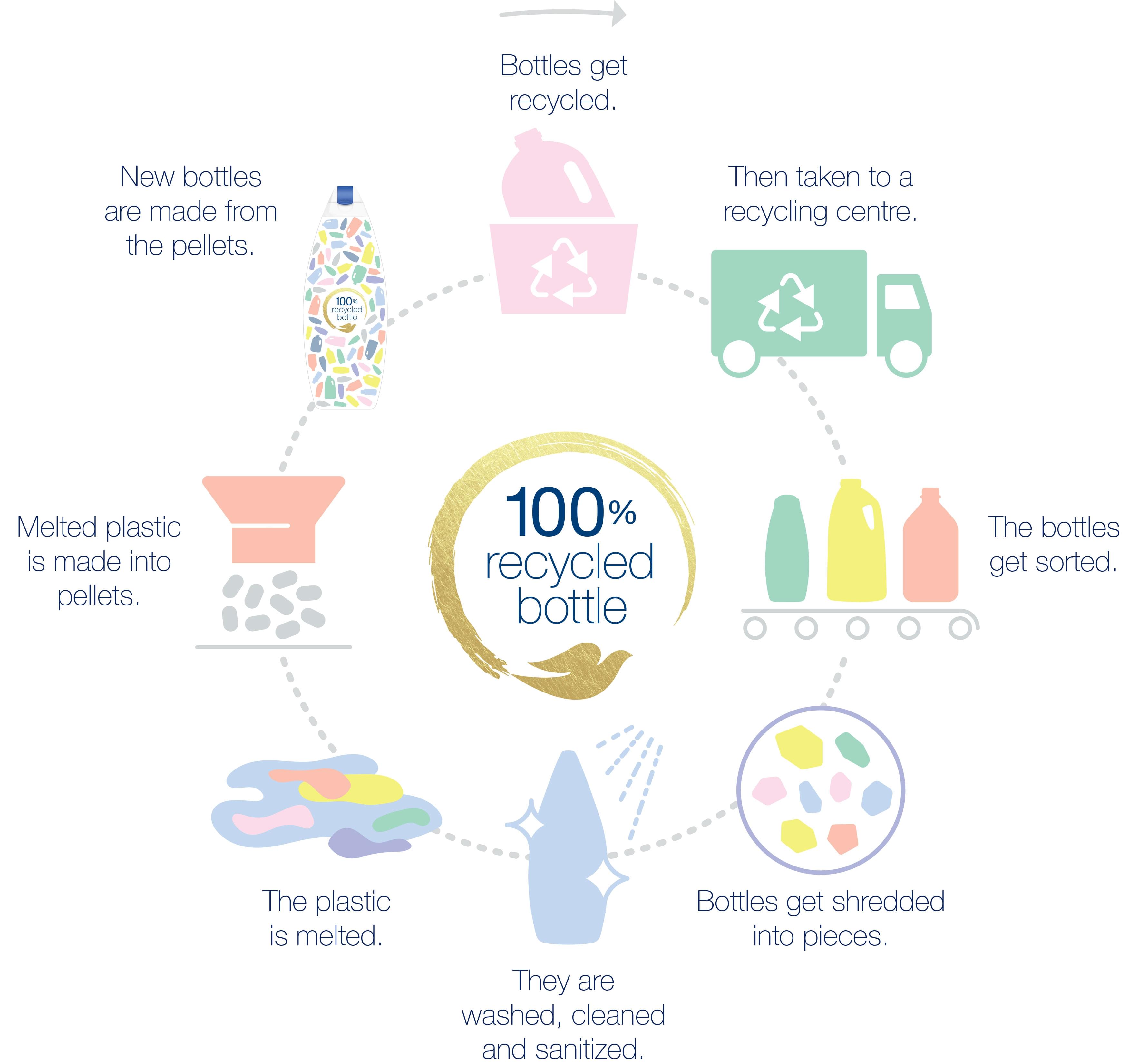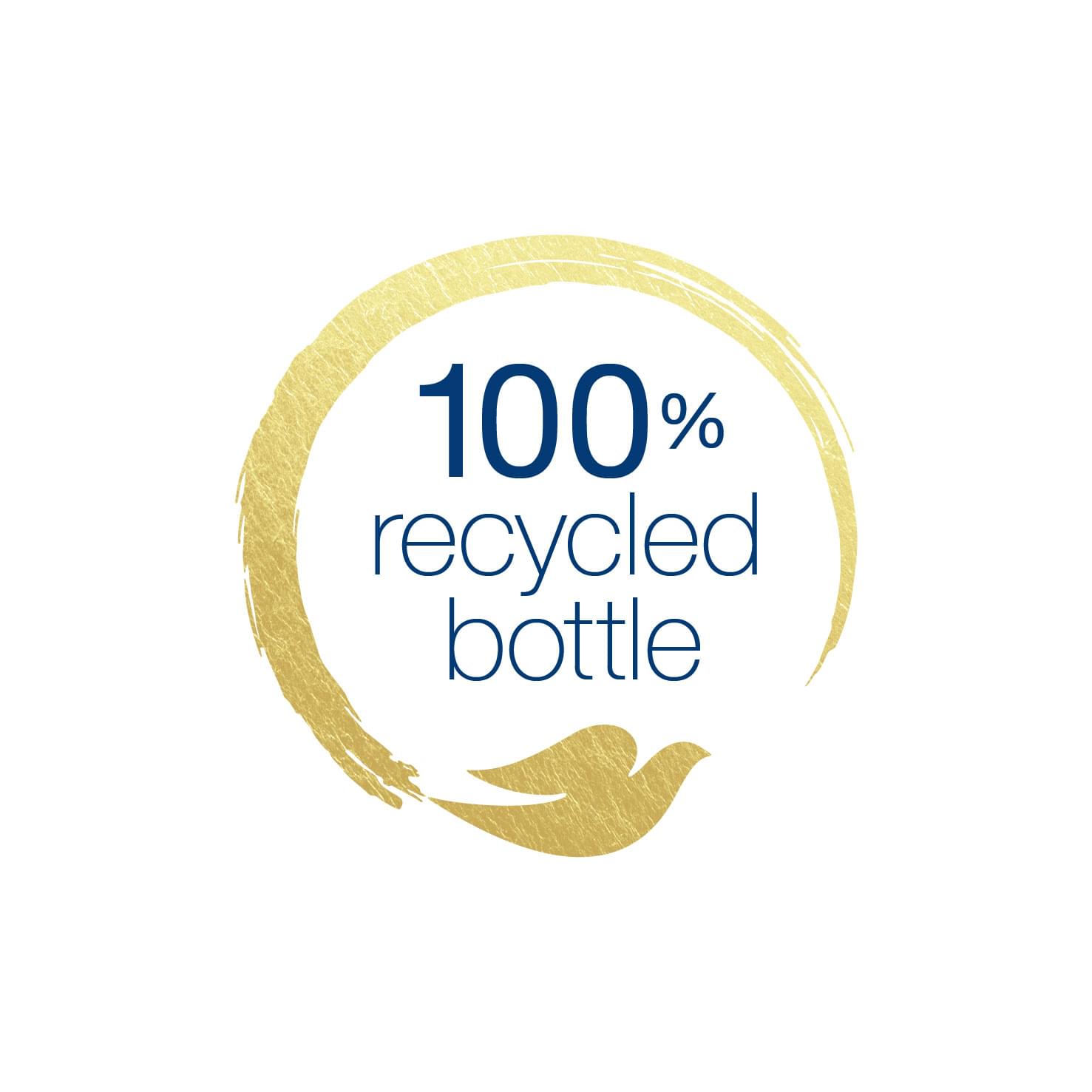Dove is re-thinking its use of plastic – for good. From the end of 2019, Dove committed to producing new 100% recycled plastic bottles across all ranges (Dove, Dove Men+Care, and Baby Dove) , beginning in North America and Europe, wherever technically feasible

The world’s plastic consumption has reached crisis proportions. To date, more than 8.30 billion tonnes of plastic has been created, and most of this has been discarded . If current rates continue, 12 billion tonnes will end up either in landfill or our natural environment by 2050.
Hitting shelves first in North America and Europe, these 100% recycled plastic bottles will have an unprecedented effect on Dove’s carbon footprint, reducing its CO2 emissions by 27,265 tonnes per year – which will result in energy savings enough to charge 3.4 billion smartphones every year.
It will also allow us to reduce our water consumption by 40% - that’s enough water to make 150 million large coffees every year.
Big changes often mean shifts in mindset, too. On our journey to 100% recycled plastic bottles, we’ve discovered that it’s not as easy as you’d think (see notes section for exceptions we’re working on) and that, sometimes, our new bottles have little quirks and blemishes as a result of the recycling process. And since that makes our bottles beautifully unique, we think it makes them even more special - a small reminder that when you pick up a Dove product, it’s got history; it’s been on a journey, and now it’s been made into a product that you can use and enjoy day after day after day. And when you think about it – what could be more ‘Dove’ than that?
Through this initiative, Dove will reduce the use of more than 20,500 tonnes of virgin plastic per year. The amount of virgin plastic Dove will save per year would be enough to circle the Earth 2.7 times.
A new era

But right now, we’re beginning by tackling one of the most pressing problems affecting the environment – and it’s one that has huge implications for the beauty industry: plastic.
Because when you step into the shower in the morning and reach for your body wash, or apply body lotion, deodorant or soap – we want you to know you’re not just using a product that understands and respects you as an individual – but that it respects its impact on the planet, too. We believe that’s an extra feel-good boost that goes to the very heart of what Dove stands for as a brand: it’s about doing the right thing, making the right choices and making every moment count.
"At Dove, we believe in care that goes further: for our consumers as well as our planet,” says Marcela Melero, Dove Global Skin Cleansing Vice President. We are passionately committed to being one of the brands making the biggest impact against plastic waste. We know we’re not perfect, but we can’t afford to wait. We’re working to have the biggest positive impact we can, as quickly as we can, and empowering others to do the same."

A lasting commitment

Dove’s commitment to get to 100% recycled bottles is the latest in a long line of the brand’s industry-leading initiatives for reducing plastic waste (in the last decade, Dove has avoided the use of more than 10,000 tonnes of virgin plastic). As the roll-out continues, the brand will continue to search for solutions where recycled plastic is not currently possible, including for caps and pumps.
And from now on, all of Dove’s steps to reduce plastic waste will fall into its NO | BETTER | LESS PLASTIC framework, which rather than focusing on one-off limited editions with short-term impact, creates a long-term and cohesive plan to ensure a greater and sustained impact

Notes to the editors
1As we move the Dove portfolio towards 100% recycled bottles, beginning in NA and Europe, there are some exceptions for certain products in these markets. These exceptions generally still contain a very high percentage of PCR and the plan is to achieve 100% as soon as technically feasible. These exceptions are:
• In North America, our Foaming Hand Wash, Dove Shower Foam and Dove Men+Care Shower Foam are 78% recycled. We continue to explore possible options to move these products to 100%.
• In Europe, our Foaming Hand Wash and Body Wash Talco are 50% because there isn’t currently enough recycled plastic, but we aim to be 100% by end of 2020.
• Certain bottles in our Hair range in NA and EU (Oxygen Moisture Shampoo and Conditioner, Volume & Fullness Shampoo and Conditioner, Clarify & Hydrate Shampoo and Conditioner) currently have no technical solution. We are exploring ways to move these products to 100%. Dove DermaCare Scalp will be 100% by the end of 2020.
• Our deodorant packs are made mainly of polypropylene. Currently, there is not enough recycled polypropylene available to allow for 100% application. In the meantime, we have started to incorporate as much recycled plastic as possible without negatively impacting the functionality of the pack. The percentage of recycled plastic used differs depending on the structures (for example, sticks versus roll-ons) and the pack colours – currently between 15% and 98%.
Dove is evaluating solutions to replace existing pumps and caps with 100% recycled materials as part of the second phase of this initiative. At present, the 100% recycled plastic commitment relates to the bottle itself.
2Science Daily, July 19, 2017, https://bit.ly/2tiKMcX
3https://www.epa.gov/energy/greenhouse-gas-equivalencies-calculator
4Standard large coffee: http://www.bluebulbprojects.com/MeasureOfThings/singleresult.php?comp=volume&unit=ltr&amt=92000000&i=421
5The equivalence figure for the amount of virgin plastic bottles Dove will save is calculated on the basis of lining up Dove 16 FL.OZ/473mL bottles end to end.


